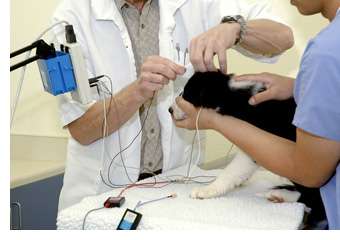
Electrodiagnostic studies are used to measure certain types of electrical activity, particularly action potentials of muscle, nerve and brain tissue. An action potential is a “spike” of electrical discharge that travels along the membrane of a cell and carries information between cells such as muscles and neurons. Electrodiagnostic studies can measure communication between these cells suggesting particular types of nervous system disease including muscle (myopathy), nerve (neuropathy) and brain (encephalopathy). In addition, certain electrodiagnostic tests can be used to screen for deafness.
Electromyography (EMG)
Electromyography measures the electrical discharges produced in muscles. During the test, two thin needle electrodes are placed in different regions of the body and a third is placed in the muscle to be studied. An instrument records the electrical activity in the muscle at rest and as the muscle is stimulated to contract. The size, duration and frequency of these signals helps determine if there is damage to the muscle or to the nerves leading to the muscle. Ideally, an electromyography study is performed on an awake patient since the muscles communicate best when the muscle cells are “warm.” The patient must remain still to eliminate unwanted voluntary action that may cause artifacts. Therefore, certain patients must be sedated in order to obtain accurate results. The test is painless and takes approximately 20 minutes. EMG’s are often performed in conjunction with nerve conduction studies. EMG is used to evaluate disorders such as myopathies, peripheral neuropathies and other lower motor neuron diseases.
Nerve Conduction Velocity (NCV) Studies
Nerve conduction velocity studies are performed by placing thin needle electrodes on the skin over particular nerves and the muscles that are innervated by those nerves. Electrical stimulation is applied to activate the nerve and see how it functions as the signal is sent along the nerve. An instrument records the velocity of the signal traveling along the nerve. This test is often performed after an EMG and is good for evaluating neuropathies caused by demyelination or axonal degeneration. Repetitive nerve stimulation may also lead to reduction of evoked potential as seen in myasthenia gravis.
Brainstem Auditory Evoked Response (BAER) Testing
During brainstem auditory evoked response (BAER) testing, earphones deliver a series of clicks to each ear. The BAER test records the electrical activity in the auditory (hearing) nerve pathway from the inner ear receptors through the brainstem to the cerebral cortex. Brainstem auditory evoked responses are evoked potentials used to detect, localize and monitor auditory and neurological deficits. No response is seen in auditory nerve disorders associated with hearing loss. Brainstem disorders may also alter the BAER. To evaluate hearing in pets without neurological disorders, the Veterinary Neurological Center routinely offers BAER clinics.
Electroencephalography (EEG)
Electroencephalography (EEG) is performed by placing electrodes on the scalp to record the electrical activity of the cerebral cortex, which is influenced by subcortical structures. The test is painless and takes about 90 minutes. The EEG is sometimes abnormal in patients with hydrocephalus, meningoencephalits, head trauma or cerebralneoplasia. An EEG may also determine whether seizure discharges are focal or diffuse. The EEG is often normal in idiopathic epilepsy, unless seizures are not well controlled and interictal spikes are present. EEG’s are not always warranted for determining brain disorders since superior diagnostic methods (e.g. MRI) provide more definitive diagnosis. EEG’s are occasionally performed at the VNC for research purposes.
This information is meant to be a guide and not a substitute for veterinary care.
Always follow the instructions provided by your veterinarian.
